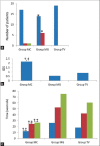Comparison of hemodynamic responses to laryngoscopy and intubation with Truview PCD™, McGrath® and Macintosh laryngoscope in patients undergoing coronary artery bypass grafting: A randomized prospective study
- PMID: 26750677
- PMCID: PMC4900407
- DOI: 10.4103/0971-9784.173023
Comparison of hemodynamic responses to laryngoscopy and intubation with Truview PCD™, McGrath® and Macintosh laryngoscope in patients undergoing coronary artery bypass grafting: A randomized prospective study
Abstract
Context: We hypothesized that reduced oropharyngolaryngeal stimulation with video laryngoscopes would attenuate hemodynamic response to laryngoscopy and intubation.
Aim: Comparison of hemodynamic response to laryngoscopy and intubation with video laryngoscopes and Macintosh (MC) laryngoscope.
Setting and design: Superspecialty tertiary care public hospital; prospective, randomized control study.
Methods: Sixty adult patients undergoing elective coronary artery bypass grafting (CABG) were randomly allocated to three groups of 20 each: MC, McGrath (MG), and Truview™. Hemodynamic parameters were serially recorded before and after intubation. Laryngoscopic grade, laryngoscopy, and tracheal intubation time, ST segment changes, and intra-/post-operative complications were also recorded and compared between groups.
Statistical analysis: SPSS version 17 was used, and appropriate tests applied. P < 0.05 was considered significant.
Results: Heart rate and diastolic arterial pressure increased at 0 and 1 min of intubation in all the three groups (P < 0.05) while mean arterial pressure increased at 0 min in the MG and TV groups and at 1 min in all three groups (P < 0.05). A significant increase in systolic arterial pressure was only observed in TV group at 1 min (P < 0.05). These hemodynamic parameters returned to baseline by 3 min of intubation in all the groups. The intergroup comparisons of all hemodynamic parameters were not significant at any time of observation. Highest intubation difficulty score was observed with MC (2.16 ± 1.86) as compared with MG (0.55 ± 0.88) and TV (0.42 ± 0.83) groups (P = 0.003 and P = 0.001, respectively). However, duration of laryngoscopy and intubation was significantly less in MC (36.68 ± 16.15 s) as compared with MG (75.25 ± 30.94 s) and TV (60.47 ± 27.45 s) groups (P = 0.000 and 0.003, respectively).
Conclusions: Video laryngoscopes did not demonstrate any advantage in terms of hemodynamic response in patients with normal airway undergoing CABG.
Figures


 ); one unsuccessful attempt (
); one unsuccessful attempt ( ); two unsuccessful attempts (
); two unsuccessful attempts ( ). (b) Intubation difficulty score; (c) intubation and laryngoscopy duration: Duration of laryngoscopy (
). (b) Intubation difficulty score; (c) intubation and laryngoscopy duration: Duration of laryngoscopy ( ), duration of intubation (
), duration of intubation ( ), and duration of laryngoscopy and intubation
), and duration of laryngoscopy and intubation  ). Values are represented as number or mean. *P < 0.05 between McGrath and Truview, †P < 0.05 between Macintosh and McGrath, ‡P < 0.05 between Truview and Macintosh
). Values are represented as number or mean. *P < 0.05 between McGrath and Truview, †P < 0.05 between Macintosh and McGrath, ‡P < 0.05 between Truview and MacintoshReferences
-
- Henderson J. Airway management in the adult. In: Miller RD, Eriksson LI, Fleisher LA, Wiener-Kronish JP, Young WL, editors. Miller's Anesthesia. 7th ed. Philadelphia: Churchill Livingstone Elsevier; 2010. pp. 1573–610.
-
- Mittnacht AJ, Weiner M, London MJ, Kaplan JA. Anesthesia for myocardial revascularisation. In: Kaplan JA, Reich DL, Savino JS, editors. Kaplan's Cardiac Anesthesia. 6th ed. Missouri: Saunders Elsevier; 2011. pp. 522–69.
-
- Shribman AJ, Smith G, Achola KJ. Cardiovascular and catecholamine responses to laryngoscopy with and without tracheal intubation. Br J Anaesth. 1987;59:295–9. - PubMed
Publication types
MeSH terms
LinkOut - more resources
Full Text Sources
Other Literature Sources
Medical
